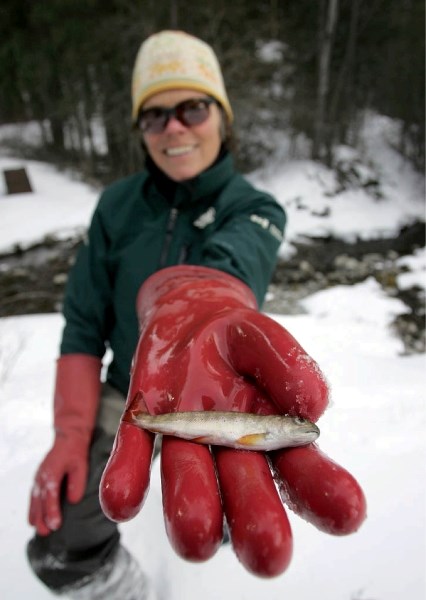A micro hydro development is being investigated to increase flows into Banff National Park’s most manipulated and regulated river as part of an ambitious environmental restoration project.
Parks Canada is working with TransAlta in a bid to increase flows in the lower reaches of the Cascade River, which, following construction of the latest dam at Lake Minnewanka in 1941, is a mere trickle compared to historical flows.
The federal agency is in the process of removing non-native brook trout from the section of river below the dam, with a long-term plan to reintroduce native westslope cutthroat once over-wintering habitat is restored.
Parks Canada officials say they are in the preliminary stages of examining a micro hydro development as a potential option with TransAlta, including whether it fits within existing national park policy.
Bill Hunt, resource conservation manager for Banff National Park, said micro hydro would allow TransAlta to improve over-wintering habitat for fish in the creek, while continuing to generate electricity.
“Putting a micro hydro in Banff National Park is obviously going to be controversial, but in this case, you’d be restoring all of that habitat, and I think there’s a really strong ecological advantage,” Hunt said.
“Micro hydro would also provide an advantage for TransAlta in leaking more water, and presumably, you can generate more power with new technology than something built in the 1940s.”
TransAlta’s Cascade hydro power plant is located on the Cascade River – the only power development in a Canadian national park. It’s part of the Bow River electric system, generating an average of 52,000 megawatt hours a year.
When the Cascade plant was built, Lake Minnewanka was created as a storage reservoir and a four-kilometre canal carries water from the lake to the Cascade plant located along the Trans-Canada Highway.
Meanwhile, the 5.5-kilometre middle stretch of the Cascade from below the dam to Cascade Ponds, referred to as Cascade Creek, is now just a small stream controlled by a riparian outflow valve at the southwest end of Lake Minnewanka.
Historically, the Cascade circumvented Lake Minnewanka and drained an area of about 660 square km, with its flows about 15 per cent of the volume of the Bow River.
With the dam controlling flows into the Cascade, flows to the historical channel below the dam have been reduced by 99 per cent.
The lower section from the power plant occasionally dries up and does not reach the Bow River, while the middle section below the dam almost never connects with the downstream section.
In fact, most people aren’t aware that the ditch that runs along the south side of the Trans-Canada Highway, beside the Legacy Trail, is part of the Cascade.
Jason Edworthy, TransAlta’s communications director, said discussions on micro hydro development are preliminary, noting a meeting scheduled for March 19 had to be rescheduled.
“It’s really, really early days, but we are rescheduling that meeting and we’ll have plenty of opportunities this spring to chat about this,” he said.
The Cascade is home to a small population of introduced non-native brook trout that have managed to carve out a living in the creek, although over-wintering habitat is very limited.
So far this winter, Parks Canada’s electrofishing team has removed 420 brook trout and hope to remove the last brookies from the system by the end of the month.
Once that is done and some habitat restoration is in place, the next step would be to reintroduce westslope cutthroat from a nearby water system, where there is a genetically pure fish stock.
Parks Canada says increases in flows would create greater habitat diversity and improve fish habitat for various fish life stages, as well as the aquatic community as a whole.
But Parks says current flows are inadequate to connect the creek system with the Bow River and say the addition of silt, taken from other locations, would help seal this system, especially at Cascade ponds.
“We’re working with TransAlta for opportunities to increase flows to meet ecological goals and restore cutthroat and, like any removal, it will take a number of years,” Hunt said.
“Before we go putting cutthroat back in, we want to make sure we’ve got all the habitat things done because it’s a lot easier to do any in-stream work when it’s empty of fish than when it’s full of a soon-to-be listed species.”
The Bow Valley Naturalists environmental organization is not outright opposed to the micro hydro development suggestion, but believe TransAlta should voluntarily release more water as a good corporate citizen benefiting financially from public resources.
They also say, while complex, criteria should be set up to evaluate the potential effects of micro hydro development against the pollution and global warming impacts of diesel generation.
Mike McIvor, the group’s president, said voluntarily increasing flows is a way TransAlta could demonstrate it has an interest in the ecological health of the national park.
“BVN is certainly interested and supportive of restoration of the river, and assuming TransAlta wouldn’t be prepared to release more water as a good corporate citizen, I wouldn’t rule out micro hydro,” he said.
“If it came to TransAlta not being prepared to contribute in that way, maybe some sort of pilot project might be worthwhile; but only on condition that’s it’s examined thoroughly in all of its complexities.”




